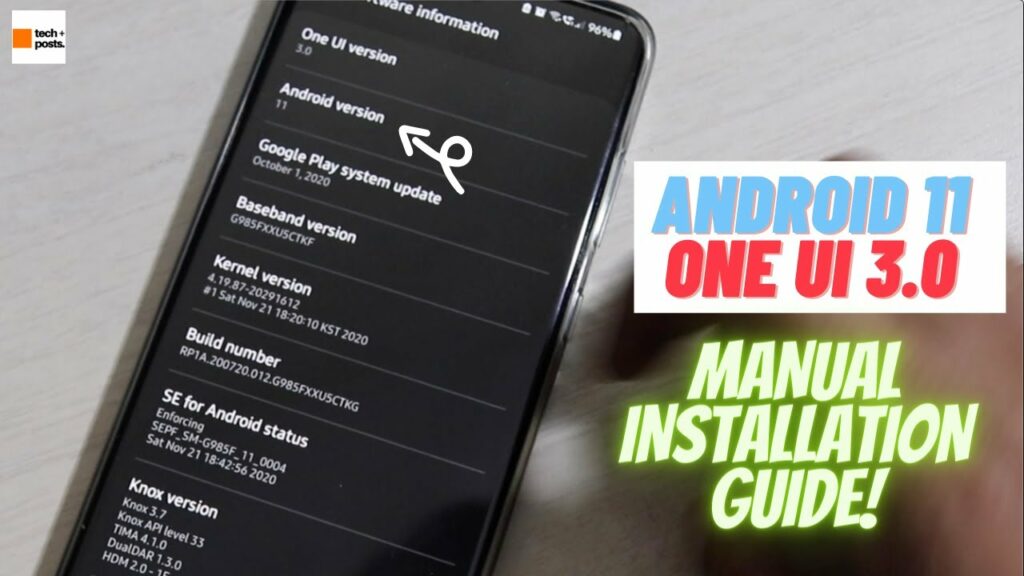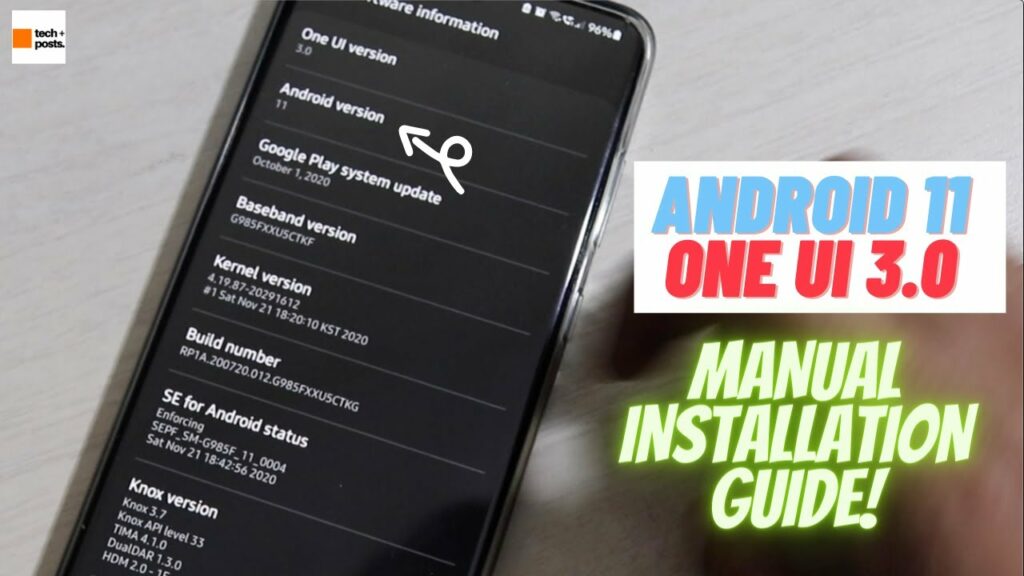Table of Contents
If you own a Samsung Galaxy S10, S20, Note 10, Note 20, or the new A and M series Android phone but haven’t yet received Android 11 or One UI 3.0 OTA update, then you can follow this guide to manually update your supported Samsung device to One UI 3.0 Android 11. This is a really simple guide and if you follow it correctly, you will be able to update your Samsung device to the latest One UI 3 Android 11.

List of Samsung Smartphones to Receive Android 11 One UI 3.0 Update
Below are two different lists of Samsung devices that may receive the Android 11 One UI 3.0 OTA updates.
List of Confirmed Samsung Devices to Receive One UI 3.0 Android 11 Update
- Galaxy S20
- Galaxy S20 5G
- Galaxy S20+
- Galaxy S20+ 5G
- Galaxy S20 Ultra
- Galaxy S20 Ultra 5G
- Galaxy Z Flip
- Galaxy Fold
- Galaxy Note 10+ 5G
- Galaxy Note 10+
- Galaxy Note 10 5G
- Galaxy Note 10
- Galaxy S10 5G
- Galaxy S10+
- Galaxy S10
- Galaxy S10e
- Galaxy Note 10 Lite
- Galaxy S10 Lite
- Galaxy A71
- Galaxy A51
- Galaxy A01
- Galaxy A31
- Galaxy A41
- Galaxy A90 5G
- Galaxy M11
- Galaxy M21
- Galaxy M31
- Galaxy Tab S6 5G
- Galaxy Tab S6
- Galaxy Tab S6 Lite
List of Devices Expected to Receive One UI 3.0 Android 1 Update
- Galaxy A10
- Galaxy A10s
- Galaxy A20
- Galaxy A20e
- Galaxy A20s
- Galaxy A21
- Galaxy A30
- Galaxy A30s
- Galaxy A40
- Galaxy A50
- Galaxy A50s
- Galaxy A60
- Galaxy A70
- Galaxy A70s
- Galaxy A80
- Galaxy A8s
- Galaxy A90
Galaxy M10 - Galaxy M20
- Galaxy M30
- Galaxy M30s
- Galaxy M40
- Galaxy Tab A 10.1 2019
- Galaxy Tab A 8.0 2019
- Galaxy Tab Active Pro
- Galaxy Tab S5e
- Galaxy Xcover 4s
- Galaxy Xcover FieldPro
- Galaxy Xcover Pro
Steps to Update Samsung Phones to Android 11 One UI 3.0
First, you need to download a few files and programs.
So start by downloading and installing the Samsung Smart Switch App on your Windows PC. We will use this smart switch app to back up our Samsung Android phone data and restore it later after upgrading the Samsung device to Android 11 One UI 3. The app helps backup and restore only Samsung devices in just a few clicks. It backups all data including your SD card. So do a backup before you proceed any further.
Next, Download the Odin App. You need to download the latest version in order to avoid any issues.
Now finally, you need to download the latest Firmware update for your Samsung device. To download the latest firmware, you need to visit Sammobile.com, register, and then sign in after verifying your Email.
- Once logged in, click on Firmware
- Click Download Latest Firmware
- Search your device model and select it. Be sure to match the Model no. of your device which you can see in About Phone under Settings on your Samsung device.
- Select or click on your country to see all the available firmware udpates
- Click on the latest firmware update from the list and then click on ‘Wait & Download’ button
- Wait for 30 sec more and then click ‘Download’
This will start the download but the download will be really slow. It doesn’t matter how fast your connection is, the download is slow from the SamMobile server. To download quickly, you can visit SamFW.com
Search your device, choose your country, and then click on the latest firmware available for your device. Be sure to match the Model no. of your device which you can see in About Phone under Settings on your Samsung device.
If you download a firmware for different model and flash it on your device, it may brick your device. And in that case I or my channel can’t be held responsible. If firmware is not available, do not try to flash any other firmware. You have been warned.
Then click on Download from Website to start downloading at full speed. This will take a few minutes if you have decent connection speed.
After downloading the firmware,
Extract it somewhere safe.
After Extraction, you need to reboot your Samsung device to Download mode. Now every device have slightly different key combination to reboot into Download mode. But sometimes it doesn’t work.
So I’ll tell you a universal way to reboot any supported device to recovery or Downlaod mode.
For this, you need to install ADB drivers on your PC. It’s really easy, just download, open the exe and enter the options to install ADB and Fastboot drivers.
Once done, in your Samsung device, open settings and go to About Phone.
Click on Software Information and then tap 7 times on Build Number to unlock Developer Options.
Then go back, scroll down and tap on Developer Options
Scroll down and find USB debugging option and then Enable it.
Now go back to your PC, make sure your device is connected to your PC, open the Command Prompt window
Type adb and hit Enter to check if adb is working. You will see a list of adb commands in output if the drivers are installed properly.
Then type adb reboot download and hit enter
This will reboot your device to Download Mode Immediately.
Now, open Odin and make sure your Samsung device is connected to your PC via USB cable. Your device should be recognized and shown as COM under ID COM.
Now click on ‘BL” button and navigate to the folder where you extracted the firmware and choose the File which starts with letter BL
Similarly, click on AP and choose the file that starts with AP. This will take time as AP file is very large. So wait until it processes. It can take more than a minute
Once AP is added, click on CP and choose the file that start with letter CP
Finally click on CSC and now you have two options
You may choose the file that starts with CSC or one that starts with Home CSC
Both are same but the only difference is that if you choose Home CSC file, it will not delete any data from your device after updating to Android 11 One UI 3. But if you select file that starts with CSC, it will flash the firmware from scratch and will delete everything from your device.
However, you should always backup. No matter what. If something goes wrong, you won’t lose your data which is really important.
Once all the files are selected, you need to click on ‘Start’. This will start flashing the Android 11 One UI 3 update to your Samsung Android device.
If the process stops with error, make sure you are using the latest version of ODIN. In case you have selected Home CSC, choose the other CSC file and then click Start. Home CSC works only for devices that are one or two updates below than the latest firmware. Thus, Home CSC may not work if your device hasn’t received any updates in last few months.
Once the device is flashed successfully, it will reboot a few times during update. This can take a while so be patient and wait for the device to boot completely.
In order to avoid any issue, make sure your device is at least 50% charged before flashing any firmware.
At this stage, your device should be updated to latest firmware which is Android 11 One UI 3. If so, please hit the like button and also subscribe for more videos and updates on Samsung devices, such as How to install Gcam on Samsung Exynos and Snapdragon devices.
Video Guide to Manually Update Samsung Devices to Android 11 One UI 3 | S10, S20, Note 10, Note 20, & More
In case you are facing any issue or problem, you can reach me via comments down below. I hope this guide was helpful.

